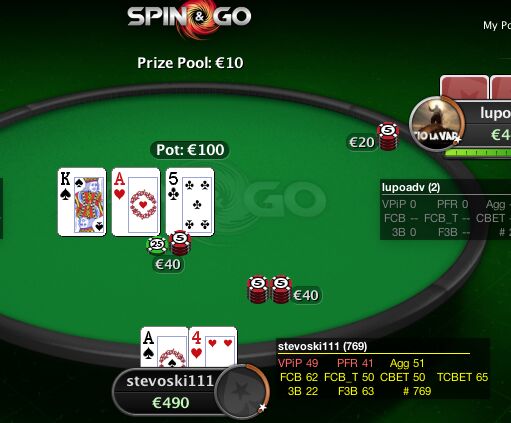What is a bluff catcher in poker?
A bluff catcher in poker means that your hand is only strong enough to “catch” (win against) a bluff, but it will lose to a strong hand. Sometimes, you’ll be confident your bluff catcher is going to win. Other times, bluff-catching can be a nail-biting experience.
Here’s a more clear definition: A bluff catcher can only call the bet and win if the other player is bluffing.
This is a necessary part of playing poker. If you only call opponents when you are sure of winning, you’ll leave valuable profit on the table. Calling an opponent with an unpaired Ace is a common example of a bluff catcher. When you call with Ace-high, you can only beat unpaired hands and other bluffs.
We’re about to look at when bluff-catching makes sense and what kinds of hands are the best bluff catchers.

How to Think About Bluff Catching
There are a few important things you need to consider before you click the Call button.
1. Is my opponent likely to be bluffing?
When you first sit down at a casino or online poker table, you might not know the players at all. If you’re a good observer, you’ll start to pick up on the tendencies of your opponents.
The best way to do this online is by using a heads-up display (HUD).

This tool is legal and even endorsed by some poker sites. You get real-time information about your opponents and you begin building a database as soon as the software is turned on. The HUD has a perfect memory and keeps track of dozens of statistics about how your opponents play.
By using a HUD (like the one shown above), you’ll see how likely it is that your opponent is bluffing in specific spots. You still have to make the final decision, but it helps you understand who you’re up against.
You can use HUDs to improve your decision-making and bluff-catching on these poker sites.
2. Why are they bluffing now?
Experienced players will often use community cards to help them make successful bluffs. Some board textures are scarier than others, for example, a board with 4 consecutive cards that could easily give someone a straight. If your opponent is skilled, they may be trying to use the board texture to make you fold a stronger hand.
There are countless other reasons why opponents may choose specific moments to bluff. Your job is to come up with that motive.
Perhaps the board has two Kings on it and your opponent is representing (acting) as if they have one. Flushes can also be used to effectively bluff opponents, it all depends on the board texture.
Position can also be a factor that causes opponents to bluff you. Continuation betting from a late position is common practice, even if the better hasn’t made a hand combination. This is especially common with hands like Ace-Queen or Ace-King that missed the board but still have high cards.

3. What are my opponent’s likely bluff hands?
Once you’ve decided that they are capable of bluffing and have a motive to do so, it’s time to consider their hands.
Your opponents are more likely to bluff when they have some equity. This is sometimes known as a semi-bluff. Here’s an example:
The board: 10♥ 3♣ J♥
Your opponent’s hand: Q♥ K♥
This is considered a semi-bluff because your opponent has a lot of equity and will make a strong hand combination a decent amount of the time.
It’s less probable that opponents will make bluffs over multiple betting rounds with zero equity, but it does happen.
Putting your opponent on a hand (estimating their cards) or a range of hands is the best way to make profitable bluff catches.
What Are Some Common Bluff Catching Hands?
Bluff catcher hands come in many different forms, but they are usually weak hands, such as one pair.
It’s impossible to sum up every kind of bluff catcher and situation, but hopefully, this gives you a better idea of potential ones.
Think about your cards as “blockers”.
The definition of a blocker is a card that eliminates one of your opponent’s possible hands. The most common example is an Ace blocking an opponent’s nut flush (best possible flush). In many situations, having the right blockers can influence your bluff-catching.
The classic missed flush draw situation.
If you’ve got some experience, you must have had this happen. You have a gorgeous flush draw on the flop, but it doesn’t complete on the turn or the river. Players are heavily inclined to turn their missed flush draw into a bluff here, which you can catch. If your opponent was on a flush draw, you can call profitably with weak and mid pairs or better.
Bluff catching with Ace-high.
Catching a bluff with ace-high is a beautiful thing. Some boards are easier than others to call with Ace-high on, such as double-paired boards (3♣ 3♥ 9♣ 9♥ 5♠ for example). On boards like this, there are lots of draws your opponent could have missed, plus fewer hands that connected. Therefore, Ace-high beats many hands your opponent may bluff with.

In this heads-up session on 888poker, a player makes a beautiful Ace-high call on the river. Learn how to set up your own private online cash games and tournaments by checking out our Poker with Friends guide.
Not All Bluff Catchers Are Weak
The thing to understand is that a bluff catcher hand is situational. The community cards dictate the possible bluffs, and therefore, the bluff catchers.
Bluff catcher hands are usually weak, but sometimes, strong hands are bluff catchers too.
Here’s a quick example for you:
- Board: K♥ Q♣ J♦ 10♠ 4♦
- Your hand: 9♠ 9♥
You’d love to have an Ace here, but instead, you have the lower end of the straight. Your hand is not the nuts; we call this the second nuts. Only one hand can beat you here (any hand with an Ace that completes the straight from 10 – Ace).
Your opponent is betting aggressively and moves all in on the river. With their bets, they represent (act as if they have) the high straight from 10 to Ace.
Even with your strong hand, you can only beat bluffs. This is an example of how the board texture alters what is considered a bluff catcher.
In our next image, we see Lex Veldhuis of PokerStars put in a tough situation. He decided to fold, but this a good example of a strong hand that becomes nothing more than a bluff catcher by the river.

Lex Veldhuis is a legend in the poker world and a regular player on PokerStars. He mainly chooses high-stakes tournaments with $100 entry fees. If you play while he is streaming, you might be able to face off against him in a tournament.
PokerStars is a great room for mid and low-stakes tournaments as well. Stars is one of the largest sites in the world and new tournaments start every few minutes. You’ll find the biggest tournaments on Sundays, like the MicroMillions events.

























